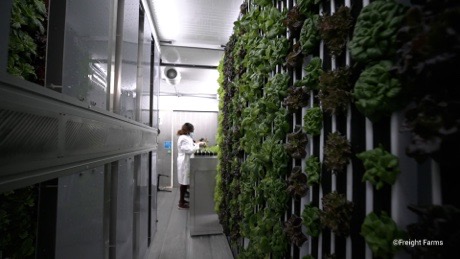4/30/2023
Modular Farming for Hyperlocal
Jennifer Polanz

I recently had the opportunity to Zoom with Freight Farms CEO Rick Vanzura, whose resume includes executive positions at Panera Bread, Wahlburgers and Borders book stores. He joined the Freight Farms team about three years ago (the company has been around for about 10 years). The company specializes in custom containers for indoor vertical farming.
“I loved the dual missions of democratizing access to food and hyperlocal sustainable sources of food,” he said of why he came on board. “But to me it was important that it was still a business I thought I could work and could scale.
“I really liked this focus on distributed modular technology and building the network effect. That’s what convinced me to join, and after three years here I’m glad I made that decision.”
Who’s The Right Fit?
Of course, this type of farming isn’t for everyone. About 70% of the Freight Farm operators are for-profit businesses that sell in one of five ways:
- Direct to consumer (the most profitable and complex, Rick noted)
- Restaurants
- Hotels
- Grocery
- Distribution
“It allows you to grow specialty crops and customize characteristics that are interesting in premium markets, like high-end restaurants,” he added. “Whether it’s growing wasabi arugula or creating a spicy arugula.”
The other 30% of operators are not-for-profit organizations like education (including universities and K-12) and community organizations to combat food deserts and develop education around growing food.
What Can You Grow and How?
Rick said the company continues to invest in R&D to find more crop opportunities. “Part of the benefit of being modular and smaller scale is we can be niche at scale. Most of CEA focuses on lettuce and tomatoes in the grocery—we have multiple markets,” he said. “We’ve actually grown over 500 different crops in the farm. We’ve established commercial viability of about 60 of them. Those 60 are largely in the camps of lettuces, leafy greens, microgreens, herbs, flowering plants and intercropping root vegetables.”
The how is with the help of Freight Farms. The unit is purchased outright, and then a monthly subscription for the software is mandatory to run it. Farmers can purchase inputs like nutrients from Freight Farm, but they don’t have to. The only thing Freight Farm doesn’t offer is seeds, but they do refer farmers to local sources. The containers are new and custom-built for growing (they initially tried refurbishing used containers but found they were too unpredictable to optimize for growing). Freight Farms offers regular support services for free, as well as a day-and-a-half training to get started and online materials. Operators can pay for someone to come out and set up the farm, too.
Rick said the vast majority of their farmers did not have any agricultural experience before starting their Freight Farm, so the support is very important through the first crop cycle. “We find after eight weeks folks are pretty self-sufficient, and again, a big part of that is because so much of it is already programmed into the software,” Rick added. The software includes recipes for a variety of crops that are preprogrammed to provide optimal light, HVAC and nutrient conditions.
Growing Better Farmers
I asked about common missteps farmers make in the beginning. Rick offered two: not being involved enough in the growing portion of the farm and not understanding the local market demand to sell product. He said while the farm is optimized for growing, it’s not like the Jetson’s, it doesn’t spit a finished plant out on a conveyor belt. Farmers still have to monitor and intervene in the growing cycle. They also have to make sure there’s a customer to buy the product after harvest, and continue to market to local buyers for the best success.
He added these systems really work best in locations where produce is difficult to access, whether it’s remote locations where it’s tough to grow food, or urban food deserts and places where there’s broken supply chains. It’s also ideal for customized, high-end opportunities.
I asked Rick if he had any final thoughts, and they weren’t necessarily about his company but about the wider industry in general:
“My big plea for all of us, which I’ve been fairly public about, is just working together and exercising our collective power. At Indoor Ag-Con honestly, I’ll sit through the occasional presentation and hear one form of CEA talking about how it’s the best and this other form isn’t the best or whatever it is. Or pick on soil farming. I come from a farming family. I firmly believe in the long run we’re going to need all of us … again, CEA isn’t going to replace soil farming, it’s going to be augmenting.
“We’re part of a large ecosystem around food production and our collective power is going to be a lot stronger than if we’re all trying to one-up each other.”